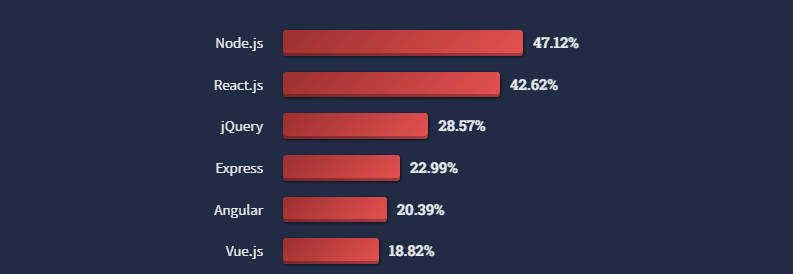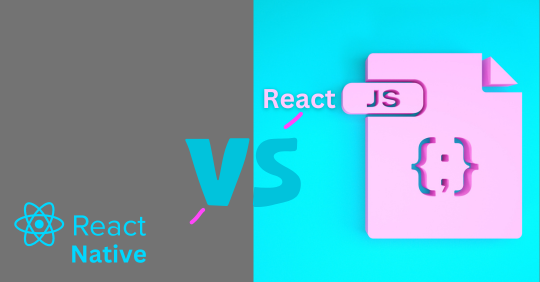Successful development of any web project, to a large part, depends upon the underlying technology. However, this poses a tricky scenario for many business owners, especially those not technologically inclined. It becomes difficult for businesses to figure out which technology they should opt for while building a website, application, or software for their enterprise.
Vue and React js are the most popular Frontend JavaScript technologies developers use worldwide. Vue.js and React.js both adopt a component-based approach to development. Hence, both technologies are appropriate for developing large-scale, complex applications.
However, the difference between these two is what needs to be parsed for you to make an informed decision regarding which one will best suit your project. Thus, if you are a business owner who wants to get a comparative breakdown between Vue js and react js, this post is for you. Hopefully, by the end of this post, you will find it easier to decide whether you will hire Vue developers or react js development agency for your project. But before we delve into the differences between these technologies, let’s first learn a little about them.
React JS and Vue JS: An Introduction
Regarding building an intuitive UI (User Interface), React JS and Vue JS are among the most preferred technologies. Let’s first learn about React JS.
React JS
React js is an open-source JavaScript Library. It was created and is still maintained by Facebook. This library is frequently used for building web and mobile applications. React can be rendered server side as well as on the client side.
React is an incredibly flexible library that provides a lot of choices to developers. There is a lot of scope or leeway for developers to explore and experiment during the development process. There is no set direction that developers need to stick to. But this approach also comes with its limitations. To make the most of React, developers should have a thorough understanding of JavaScript. Moreover, they must also have experience building Single-page applications (SPA) design. Hence, for beginners, reaction poses a steeper learning curve.
Features of ReactJS:
- Resource-rich library: The huge and active community of React developers is there to help every time a fellow developer experiences an issue. The community contributes to the maintenance and upkeep of React js, making it significantly more feature-rich.
- Reusable components: With Reactjs, developers can reuse code components across different levels of a project. Hence, they can develop at a lightning pace.
- Scalable projects: React’s modular architecture lends itself well to large-scale projects. Primarily because of its flexible structure and easy scalability, react is well-suited for complex projects that are massive in size.
Pros of ReactJS:
- Quick client-side rendering that enables developers to render complete websites just using JavaScript. They don’t have to create a distinct HTML page for each route. Instead, every router gets dynamically created by the client-side website.
- React employs unidirectional data flow. Data can only move in one direction while being transferred between various application parts. As a result, you get improved control over the data flow, and you can maintain a clean data flow architecture.
- React is lightweight. It means that instead of giving in-built features, it provides the choice to developers regarding what they want to use and what they don’t want to use.
Cons of ReactJS:
- React uses JSX syntax, which stands for JavaScript XML. It is a syntax extension that allows developers to write HTML-esque code in JavaScript files. This syntax allows developers to write more succinct and maintainable code for their user interfaces. However, it also makes ReactJS more difficult to learn.
- React does not have official libraries that can tackle general frontend features such as routing, HTTP requests, etc. It requires other libraries and services, such as Redux, routing, and others, to function.
Vue JS
Unlike React JS, which is a library, Vue js is a JavaScript frontend framework. Released in 2014 by Evan You, Vue Js offers progressively responsive UI enhancements. Vue JS blends the best of React and Angular js to provide a potent, easy-to-navigate user experience.
Vue.js includes Angular js properties such as directives, two-way data binding, and components. On the other hand, Vue also includes React JS properties such as Virtual DOM and single file components, providing enhanced performance.
Features of Vue.js:
- Adaptability: Migration is hassle-free with Vue js’ simple and efficient structure.
- Components: Vue enables the creation of custom elements that can be reused in HTML.
- Transition: Vue js facilitates easy application of a transition to HTML components as they are added or removed from the DOM.
- Detailed Documentation: The learning curve is a lot simpler because of the detailed step-by-step documentation that it provides.
Pros of Vue.js:
- Vue js is a developer-friendly framework because it provides easy customization and scalability options. Using Vue js, you can integrate multiple projects and develop applications without any hiccups.
- Vue has excellent speed. At a manageable size of 22.9 KB, Vue progressively integrates different parts of its technology.
- The way code is stored in Vue in separate files makes it very organized and structured, making it easier to read and maintain.
- Vue JS is written in elegant language syntax. It is easy for developers to write concise, consistent, expressive, and clear code in Vue js.
Cons of Vue.js:
- Vue hasn’t been around for that long. Hence, it is not easy to find and hire Vue js developers that are experienced.
- The community, even though active, is quite small.
- A large part of the documentation is only available in Chinese. As a result, non-native speakers have to jump hoops to get translations of forum conversations, plugin descriptions, and other such instructional information.
Commonalities between React js and Vue js
Before we delve into the differences between React and Vue, it is important to acknowledge that they also have a few commonalities. Following are some common traits shared between React js and Vue js.
- Virtual Dom: Both React and Vue use Virtual DOM as an abstraction of the HTML DOM. With Virtual DOM, you get improved performance.
- Lightweight: Both React as well as Vue are lightweight technologies.
- Component-Based Architecture: Both technologies use a component-based architecture where independent parts can be reused without impacting other parts of the project.
- Proactive communities: Even though there might be a difference in the size of the two communities- React’s being a lot bigger than Vue’s; both the communities are quite active and provide robust support and resources to any developer who might get stuck somewhere.
And yes, there is another commonality. React and Vue are among the most favorite web frameworks and technologies of developers, according to StackOverflow Survey 2022.

(Pic Reference)
Differences between React js and Vue js
Let’s dissect the differences between React and Vue by starting with the most obvious one- React js is a Library, whereas Vue js is a framework.
As a JavaScript library, React provides a more mature toolkit to developers than Vue Js. It also has a bigger community compared to Vue. Known for its flexibility, React.js can be used alongside a spectrum of other UI libraries. It is the most preferred choice of developers when it comes to developing large-scale applications with quite a bit of complexity and nuances.
On the other hand, Vue JS is a progressive framework. It can function both as a compact library and as a complete framework. It is super easy to learn and start with Vue JS, so beginners prefer Vue over React. The most notable thing about Vue js is its performance and ability to integrate with other technologies such as TypeScript and GraphQL.
We have summarized all the major differences between React and Vue in the table below:
| Points of Difference | React JS | Vue JS |
| Definition | JavaScript library | JavaScript framework |
| First release | 2013 | 2014 |
| Website | https://react.dev/ | https://vuejs.org/ |
| Examples of websites/apps | FacebookInstagramPinterestNetflixTwitter | BehanceGitlabTrivagoStatista9GAG |
| Component | It utilizes JSX as a component format. | Utilizes templates to create different components. |
| Architecture | For complex features, react supports diverse state management libraries. | For various complex features, Vue uses its malleable architecture. |
| CSS(Cascading Style Sheets) | It supports CSS by importing components or adding script files to the JS file. | By embedding CSS code inside of JS, it supports CSS in JS. |
| Maturity | More Mature | Less Mature |
| Community | Community is bigger | Community is smaller |
| Flexibility | More Flexible | Less Flexible |
| Performance | Exceptional | Up to the mark |
| Learning Curve | Relatively harder learning curve. | Easy to learn, and thus, beginners friendly. |
| Use Cases | Appropriate for larger, more complex, and nuanced projects. | Well suited for small and medium-sized applications. |
| Important Features | It is used to develop single-page applications and mobile apps.Used Frequently by developers worldwide.Elegant programming style.Rich packaging ecosystem. | It is used to develop progressive web applications.Used frequently by developers worldwide.Relatively easy to learn, even for beginners.Detailed documentation is available. |
| Pros | It is easy to get started with React. There are several third-party add-ons available. | Set up is easy, and so is getting started with Vue.A majority of the development needs are covered by Native modules. |
| Cons | The majority of the extensions are not official.Beginners face a steep learning curve. The official documentation is not available. | There are not many third-party add-ons available. The community and the ecosystem of Vue are relatively smaller.Compared to react, Vue is not that well maintained. |
| When to use | When the project involves multiple interdependent state changes.When you want to revitalize unresponsive pages by enhancing their speed and performance.When you want to get a handle on your codebase.When you want Frontend UI to support high user interaction.When you want to develop a large application in a short turnaround time. | When you need ample flexibility and scalability while building your application.When the project is small or medium-sized.When you want to develop an MVP with limited testing features.When you need to speedily migrate the codebase of your existing solution and integrate with essential apps like SPAs and MPAs.When you need to incorporate animation. |
How to Make the Right Choice for Your Project?
Now that you have an idea about how React and Vue differ from one another, you are probably in a better position to choose between the two technologies when it comes to your enterprise project. But if you are still confused about which framework would better suit your project, consider the following:
● What exactly does your team’s expertise lie in?
Rely on your strengths. If your team has experience handling Vue projects, it would be better for you to go with Vue. However, if you are outsourcing the project instead of hiring an in-house team, then it would be better to go with React, as it is incredibly hard to find talented and experienced Vue JS developers. In comparison, you will be able to find Reactjs development services easily.
● What is the scale of your project, and how complex is it?
Suppose you outsource the project to a react js development agency offering vue js development services. In that case, you can always ask their opinion on which technology best suits your product. However, if you are skeptical about how honestly they would answer, it is better to decide yourself. But how can you do that? Well, the best way is to look at the scope and scale of your project. In the case of a bigger and more complex project, go with React js. However, Vue should be your choice if your project size is small.
● What is your budget?
Economics is a factor in web development that cannot be ignored. If you have a tight budget, Vuejs is a cost-effective choice. However, if you have a sizable budget for your project, you can opt for React.
Conclusion
Both technologies offer several benefits. React provides its customers additional power because it is a library, like the ability to manually re-render. It makes extensive use of functional programming techniques. In comparison, the core team of the Vue framework has added additional built-in capabilities and partner libraries. It facilitates a more seamless development process.
The ideal option for you will ultimately rely on your unique needs and demands. Vue.js is a wonderful option for beginners since it is simple to use and understand. However, React.js is the better option for developing a huge and complicated application because it is established, adaptable, and efficient.







Related posts